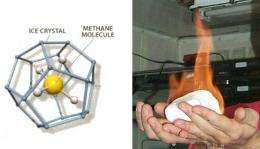March 12, 2010 report
China looks to 'combustible ice' as a fuel source

(PhysOrg.com) -- Buried below the tundra of China’s Qinghai-Tibet Plateau is a type of frozen natural gas containing methane and ice crystals that could supply energy to China for 90 years. China discovered the large reserve of methane hydrate last September, and last week the Qinghai Province announced that it plans to allow researchers and energy companies to tap the energy source. Although methane hydrate is plentiful throughout the world, the key challenge for China and other nations will be to develop technologies to excavate the fuel without damaging the environment.
Methane hydrate is an ice-like substance that is sometimes called “combustible ice” since it can literally be lit on fire and burned as fuel. But rather than dig up the substance, excavators would likely melt the ice underground first, and then extract the methane gas. However, researchers are still investigating the most appropriate way to extract the fuel for commercialization.
Methane hydrate is an attractive energy source due to its high energy density: one cubic meter of combustible ice contains about 164 cubic meters of regular natural gas. This high energy density is due to the fact that methane is trapped within the hydrate crystal structure and greatly compressed. According to the DOE, the immense energy content of methane occurring in hydrate form may possibly exceed the combined energy content of all other known fossil fuels. In addition, the frozen hydrate has few impurities, meaning it can burn cleaner with fewer pollutants than oil and possibly regular natural gas, as well.
Combustible ice has already been discovered in more than 100 countries, buried in both the Arctic permafrost and beneath the ocean floor. Besides China, countries including the US, Japan, and the Republic of Korea have plans to tap the natural gas hydrate buried in their territories. Last summer, US scientists on a research vessel in the Gulf of Mexico discovered pockets of highly concentrated methane hydrate estimated to contain 6,700 trillion cubic feet of gas. The DOE has estimated that the total amount of methane hydrate worldwide could be as high as 400 million trillion cubic feet, including 85.4 trillion cubic feet buried in Alaska.
Because methane is a potent greenhouse gas, researchers are also concerned about the environmental effects of extracting methane hydrate. However, if handled carefully, using methane hydrate as a fuel could be safer than simply letting it melt on its own. As the earth continues to warm, methane released into the atmosphere could cause even more damage than if it were burned for fuel. On the other hand, if large amounts of methane were accidentally released during extraction, the results could further aggravate global warming. Another risk from mining the combustible ice is geological slumping.
For these reasons, developing a safe technology to excavate the fuel is a priority. With these challenges in mind, China's Ministry of Land and Resources estimated last week that the country could begin using its combustible ice within 10 to 15 years, joining other countries in methane hydrate exploration.
More information: via: Xinhuannet and the US Dept. of Energy
© 2010 PhysOrg.com
















